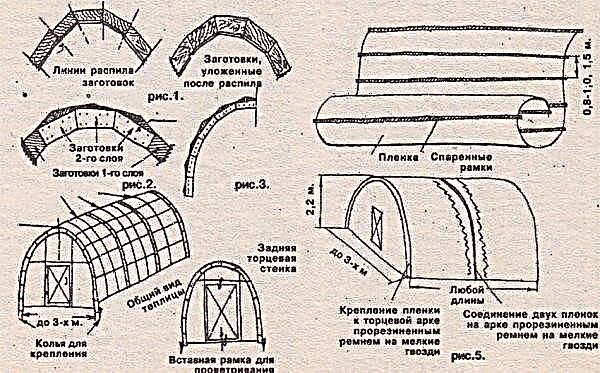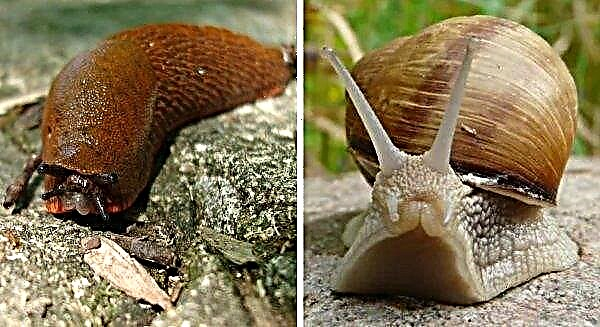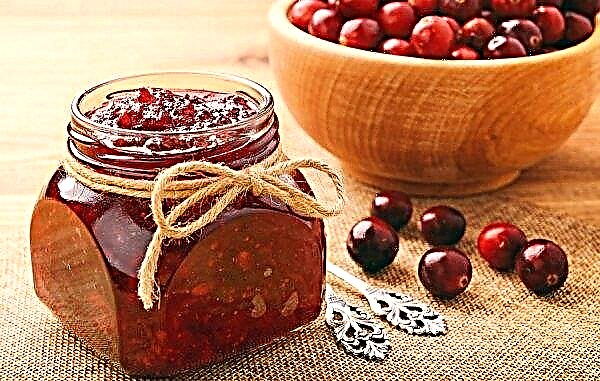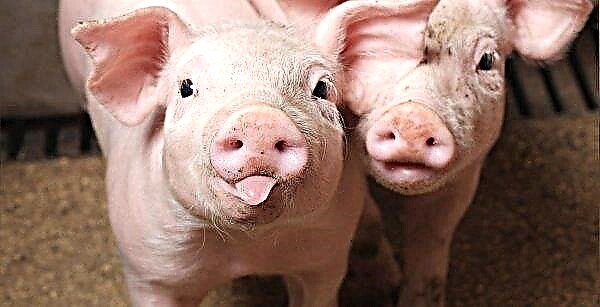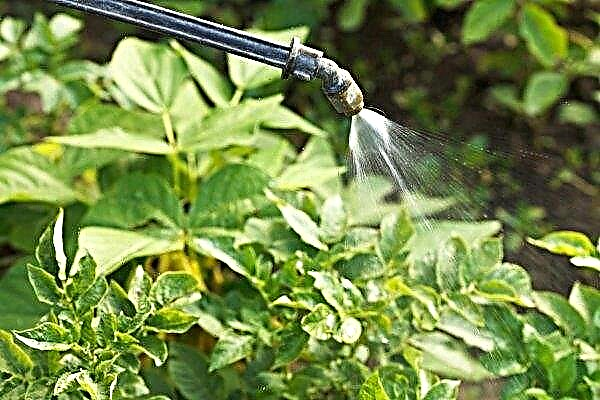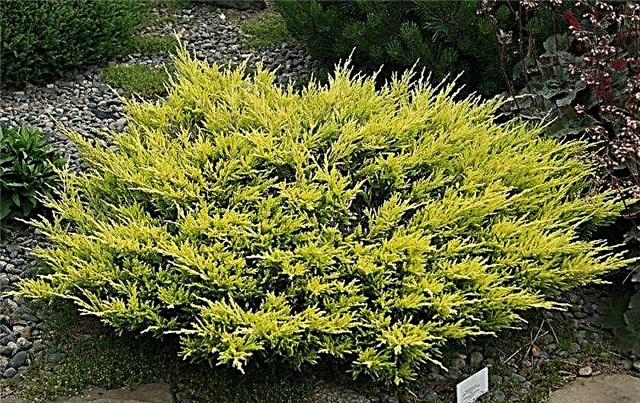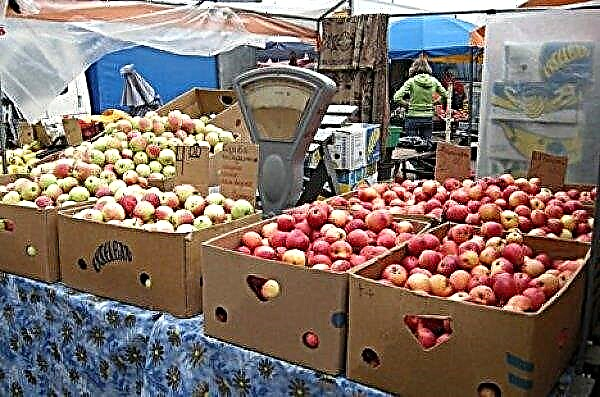A large number of summer residents are planted in their areas of thuja. These plants are ideal for creating designer compositions. They are also very unpretentious in the care and cultivation. But there is a risk of damage to decorative trees by various diseases or harmful insects. About the most common enemies of conifers and methods of dealing with them - later in the article.
Thuy diseases and their treatment
Among the most common and dangerous diseases can be called such as shute, rust, late blight, necrosis, root rot, fusarium. Plants infected by them most often die. Therefore, it is necessary in the early stages to be able to recognize harmful symptoms and conduct treatment on time.
Important! Be sure to trim the old and damaged branches, they need to be burned. Since these shoots can be a source of infection with diseases and pests.
Schütte
Fungal disease characterized by the following symptoms:
- the needles turn yellow in the spring;
- a dense web appears on the thuja, first gray, later becoming black and brown;
- the needles therefore stick together.

You can fight the disease by spraying with the Topsin-M preparation (15 g per 10 liters of water), 0.7% Kurzat solution, 0.5% copper chloroxide, 0.2% Fundazole solution, etc. It is also very important to carry out preventive measures: cut dry and diseased branches, treat with 1% Bordeaux mixture, iron or copper sulfate in spring and autumn.
Rust
The main signs of rust on thuja:
- turns brown and falls off needles;
- mostly young shoots are affected.

For the treatment of this ailment, it is best to use the drug “HOM” (40 g per 10 liters of water). Spray in spring and summer (in case of repeated development). It is also possible to treat the near-trunk zone with the chemical agent “Fundazol” (20 g per 10 l of water). For prevention, you need to use the fungicide "HOM" only 1 time in the spring.
Phytophthora
A very dangerous disease that destroys the plant completely and is manifested by the following symptoms:
- the top of the plant bends;
- the tree begins to fade;
- a gray shade appears on the needles;
- the trunk below softens and becomes brown inside;
- a putrid odor appears in the basal zone;
- the root breaks easily.

It is impossible to cure plants from late blight. Trees must be destroyed immediately in order to avoid expanding the range of harmful influence. Disinfect the earth. To prevent the occurrence of ailments, seedlings should be planted in areas with good water permeability.
Did you know? Thanks to the healing and decorative qualities of thujas, they were constantly planted in royal parks in France.
Root rot
Another disease affected by plant roots and caused by a fungus. It can be distinguished by such signs:
- thuja shoots first turn yellow, later brown;
- a white coating appears on the bark and wood of the arborvitae;
- the root neck turns brown;
- young trees die very quickly.
In this case, infected thujas are not restored. They must be destroyed immediately. Neighboring trees should be watered with a 0.2% solution of “Rovral Flo 255 SC”.

Necrosis
This disease is caused by several types of fungus. It manifests itself with the following symptoms:
- the bark in the affected areas becomes brown;
- shoots of plants die;
- the needles turn yellow from above and go down; later it darkens and falls.
 If necrosis occurs, the affected trees should be cut and burned. Nearby, growing plants should be sprayed with 0.1% Topsin M 500 SC.
If necrosis occurs, the affected trees should be cut and burned. Nearby, growing plants should be sprayed with 0.1% Topsin M 500 SC.
Fusarium
It affects the root system of conifers. The causative agent is a pathogenic fungus. You can distinguish this disease as follows:
- the roots turn brown;
- the needles wither, turn yellow, blush and fall;
- over time, the trees dry out.
The disease occurs when thuja is planted in areas with stagnant water, with poor permeability of the soil and insufficient lighting. The fight against Fusarium infection consists in treating plants with a 0.2% solution of Fundazol, Abiga-Peak, HOM, etc.

Thuje pests and the fight against them
In addition to fungal diseases, there are also other enemies of thuja - harmful insects (spider mites, aphids, luboed, speckled moth, leafworm). They also cause great damage to plants, often leading to their death.
Important! All chemicals must be used in accordance with the instructions attached to them. You should also adhere to the rules of your own safety when working with them.
Spider mite
Mainly attacks trees growing on dry soils. The appearance of a spider mite on thuja is accompanied by the following:
- a web appears on the branches;
- the needles become covered with yellow spots, crumble.

After the first signs appear, you need to treat the trees with dandelion infusions (pour 300 g of chopped dandelions in 10 liters of warm water and leave for 5 hours), garlic (150 g of dry garlic husks pour 10 liters of water and leave for 24 hours) or colloidal sulfur solution (40 g per 1 a bucket of water). Keep the thuja moistened with cold water (this repels ticks).
Aphid
Harmful insect sucking juice from young shoots. For a season can give up to 5 generations. Sick trees have the following appearance:
- the needles turn brown;
- plants fall in the fall and winter;
- aphid forms on the surface of the colony in the form of a white coating.
In this case, two-time treatment of thuja with the preparations “Karbofos” (60 g per 8 l of water), “Fitoverm” (4 ml per 1 l of water, working solution), etc. is recommended.

Luboed
Thuja beetle eater feeds on bark, bast, wood of branches, thereby greatly damaging plants.
You can detect it by the following signs:
- small holes are visible on the cortex;
- shoots fade and dry;
- tree partially or completely perishes.
You need to treat thuja from this insect with the help of insecticides such as Karbofos (90 g per 10 liters of water). In preventive measures, it is recommended to carefully examine young seedlings, thereby preventing pest infection of plants. In spring, treat with a 1% solution of Bordeaux fluid.

Speckled Moth
A small 4 mm butterfly poses a great threat to conifers. The harm she inflicted looks like this:
- the tops of the trees turn brown;
- the tips of the branches die;
- small holes appear on damaged surfaces.
To prevent mass destruction of thuja, it is necessary to trim damaged shoots. Also spray with chemicals Fumitox Antiklesh, Tornado Antiklesh, Moskitol Antiklesh.

Leaflet
Another common pest of thuja is leafworm. The insect lays eggs in the cracks of the bark, from which caterpillars hatch over time and eat young shoots.
It is characterized by such signs:
- cocoons with caterpillars in the middle appear on the needles;
- coniferous plant wrapped in cobwebs;
- trees lose their beautiful appearance;
- arborvitae are ill and perish.
Prevention is that you need to treat the trees with Fufanon preparations (1 ampoule per 1-2 liters of water working solution), Decis Profi (1 g per 10 liters of water), Actellik (15 g per 10 liters of water) .

Prevention
In order to avoid the appearance of any diseases or harmful insects on thuja, preventive measures play an important role.
Did you know? In ancient centuries, thuja needles were used for sacrificial burns.
They do not require much effort and are as follows:
- regularly inspect plants for any damage or changes;
- to plant trees in open sunny areas with loose soil;
- in spring and autumn, prune old, sick and damaged branches;
- purchase healthy planting material from trusted suppliers;
- carry out preventive spraying in the spring;
- moisturize and feed the trees in time.
 All these procedures will help protect conifers from diseases, as well as make them stronger and more beautiful.
All these procedures will help protect conifers from diseases, as well as make them stronger and more beautiful.
Despite the fact that the arborvitae are very unpretentious, some care should be taken. Particular attention should be paid to protection against the harmful effects of diseases and insects. Thanks to these actions, coniferous representatives will be able to decorate any garden plot with their appearance, bringing aesthetic pleasure to their owners.

